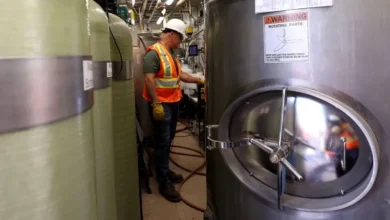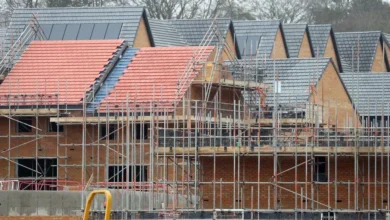‘Nature designed it to bend’: The bamboo buildings that sway in earthquakes
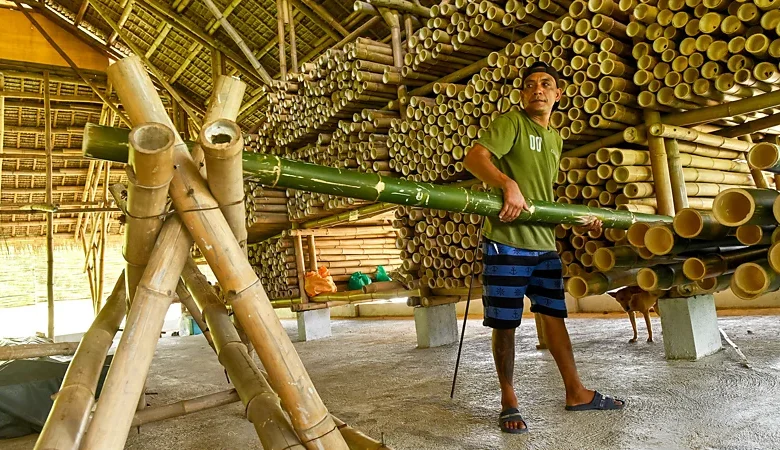
As well as being cheap, bamboo appears to have remarkable qualities of seismic resistance. Now it’s being used to try to protect people from earthquakes.
When a 7.8-magnitude earthquake struck Ecuador in April 2016, the coastal city of Manta was heavily damaged. Its vibrant central commercial district, Tarqui, was levelled completely. City streets were scarred by deep fissures that swallowed the brick and concrete rubble of buildings.
Today, Manta is largely rebuilt, but one unexpected part of the legacy of that earthquake is still visible. In the area that was the city’s ground zero during the earthquake, a fish market stands beneath a bamboo pavilion by the shore. There’s the tourist information centre, a restaurant and a fire station, all built with bamboo. In fact, throughout the city and the surrounding province of Manabí, hundreds of traditional bamboo homes still stand.
“They were all built before the earthquake,” says Pablo Jácome Estrella, the regional director for Latin America and the Caribbean at the International Bamboo and Rattan Organization (Inbar). “They stayed standing.”
Buildings should move in an earthquake. We just want to control how much they move – Bhavna Sharma
Bamboo has been used as a building material for millennia in South America, Africa and Asia, and grows in abundance in many countries in these regions. But only recently has its seismic resilience started to be more widely recognised through a growing body of research and laboratory shock tests, which indicate that its remarkable natural properties could make it ideal for withstanding earthquakes. Today, construction projects across the world, from the Philippines to Pakistan to Ecuador, are seeking to utilise the natural material that engineers and architects compare favourably to steel.
Buildings that bend
People on Ecuador’s coast used to wait for the quarter moon to harvest bamboo before carrying it into the sea to clean and preserve it, Jácome Estrella says. “We say we have 10,000 years of history of bamboo,” he says. Other cultures have also long used bamboo to construct ceilings or other interior elements.
Despite this history, bamboo’s potential was not always obvious in Manabí. In the 2000s, Jácome Estrella says, a local architecture professor in Manta realised the city’s fire department prevented bamboo construction, believing it to be flammable (which it naturally is, but this can be reduced using fire-retardant treatments). So he started working as a volunteer firefighter. “He convinced them to build a fire station with bamboo,” he says.
That fire station, with its sweeping vaulted roof large enough to accommodate several hook-and-ladders and water tankers, survived the 2016 earthquake. “Nature designed it to bend,” says Bhavna Sharma, an associate professor at the University of Southern California whose research focuses on the use of bamboo in construction.
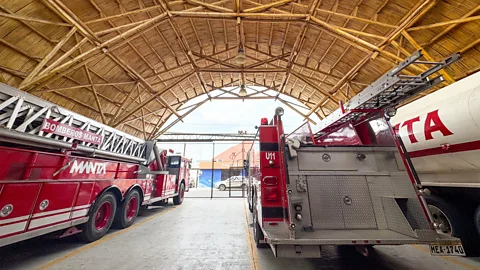
Bamboo culms (the upright, hollow stems) are lightweight, reducing the mass of a structure, and research shows that the ductility that allows them to withstand high winds also allows them to absorb seismic shock. “Buildings should move in an earthquake,” says Sharma. “We just want to control how much they move.”
A post-earthquake survey of over 1,200 buildings in Manabí found that overall, reinforced concrete buildings experienced greater levels of damage than timber and bamboo buildings, says Sebastian Kaminski, a structural engineer for UK-based construction consulting firm Arup, who was part of this mission. However, the trend was reversed in some towns, he notes, adding that post-earthquake data also needs to be taken with some caution. In this case, for example, it was collected several weeks after the event, when many buildings had already been demolished.
Today, a project launched in 2021 by Inbar and the Spanish Agency for International Development Cooperation has built hundreds of new bamboo homes in Manabí, the Ecuadorian province where Manta is located. It has also taught some 200 students at the University of Manabí bamboo construction techniques, such as treating bamboo stalks and assembling panels.
It costs less than $20,000 (£14,900) to build a two-bedroom home, Jácome Estrella says – about the same as a house built with more conventional materials. “There is a phrase we use: it’s the wood of the wise,” he says of bamboo. “[It] is renewable, sustainable, with low impact to the market.”
These new homes are inspired by a traditional building method called bahareque, known in English as wattle and daub, where a mesh of bamboo is covered with a layer of wet loam soil.
Game changer
Researchers began looking seriously at bamboo around the turn of the century. In 1999, after a 6.2-magnitude earthquake struck the coffee growing region of mid-west Colombia, observers noticed that bahareque structures had seemingly survived at a higher rate than those built with masonry materials, like bricks and cement blocks.
“That earthquake changed the game,” says Luis Felipe Lopez, general manager of the Manila-based Base Bahay Foundation, which develops and builds bamboo homes in the Philippines. “It was so evident to the government that these bahareque houses saved a lot of lives.”
Lopez, who was born in the region of Colombia affected by the earthquake, was at this time working on his structural engineering thesis and noticed a dearth of research into the structural properties of bamboo. Global building codes had been developed using centuries of research by engineers in the US and Europe who “never saw bamboo in their lives”, he says. And the Global South had “copy and pasted its building codes from the north”.
 Base Bahay
Base BahayThe earthquake inspired the government of Colombia to invite experts, including Lopez, to research the properties of Guadua bamboo, the domestic species used in bahareque construction. In 2002, using their findings, Colombia became the first country to have a building code specifically for bamboo construction.
Lopez eventually took his work to Base Bahay, which was founded in 2014 to create a laboratory to study bamboo’s performance. The Philippines, which experiences frequent typhoons and earthquakes, became a perfect location – just as researchers in the US and Europe became fascinated with studies on bamboo that had been concentrated mostly in Latin America.
“Universities in the global north said, wait, this material looks super interesting,” Lopez says. “Because it’s the moment when climate change had started to be a topic.”
Bamboo forests are incredibly fast growing and act as carbon sinks, absorbing more carbon than they release, so building with bamboo rather than materials like concrete and steel can drastically reduce a structure’s embodied carbon. It is also cheap and locally available in many countries.
“That’s part of the selling point of bamboo, the benefits in terms of regenerative forestry, but also the ideas of sustainability in terms of economic and social equity,” Sharma says.
The balmy climates of the southeast US, can support bamboo plants for commercial and construction use, which has caught the attention of some materials researchers
Since 2014, Base Bahay has built more than 800 homes in 10 communities throughout the Philippines, starting in the region of Bicol, which experiences yearly typhoons. The homes are built with composite bamboo shear walls, a system inspired directly by bahareque in which bamboo panels are wired together with mesh and finished with cement or lime.
The homes have yet to be tested by major earthquakes, although they have withstood numerous typhoons, Lopez says.
The triangular shape of the bamboo panels provides stability in earthquakes, which move horizontally, and the connections within shear walls can absorb the winds of a typhoon just as they do seismic energy.
“It’s light enough for an earthquake and heavy enough for a cyclone,” says Liu Kewei, an engineer for Inbar who has worked to develop the technique.
“Architects will always say that natural bamboo is a gift of God. Because nature created these kinds of plants in a hollow way.”
A global push
When I visit Base Bahay’s lab in the heart of Manila, the Philippines’ capital, in February 2025, Lopez and I walk leisurely around. We pass researchers from Filipino and UK universities conducting tests on harvested bamboo plants as well as manufactured bamboo – products fused into standardised shapes and sizes like timber.
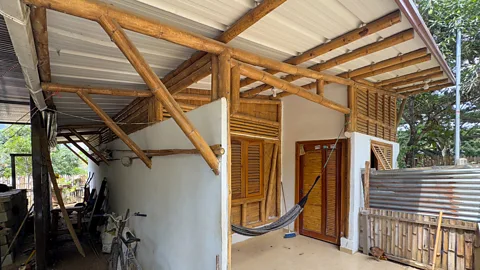
Lopez and his colleagues have published many papers on bamboo’s seismic performance over the years. Aside from his work in Colombia and the Philippines, he has become a contributor to ongoing efforts to standardise global bamboo building codes.
But including bamboo in standardised building codes remains difficult. Unlike manufactured wood products, non-engineered natural bamboo culms are hard to standardise, as they differ in size and shape, despite containing similar structural characteristics. “You just treat it and that’s it,” says Lopez. “You use whatever nature gives you.”
Still, since the 1999 Colombia earthquake, bamboo building codes have been adopted by the globally recognised International Organization for Standardization. The latest code, published in 2021, “remains the current state-of-the-art”, says Kaminski, who contributed to its development.
Governments in Peru, Ecuador, Bangladesh, India and Mexico have also developed national bamboo codes, and the Philippines and Nepal are currently developing them, he adds.
The balmy climates of the Southeast US, however, can support bamboo plants for commercial and construction use, which has caught the attention of some materials researchers.
Like any material, the behaviour of bamboo buildings in an earthquake depends on how well it is designed, built and maintained, says Kaminski. “If any of these are not done well, bamboo buildings can be as vulnerable [to earthquakes] as other materials,” he says.
The saving graces of traditional bamboo buildings, he adds, is that they tend to be light, and thus attract smaller earthquake forces, can absorb some energy and have some tying of the poles. “Crucially, since they tend to be light, their collapse is less of the life safety risk to the occupants.”
Kaminski says that in his experience, communities often trust that bamboo can resist earthquakes but do not believe the material to be durable, as they are familiar with traditional structures that are not treated to fully protect against insects and water infiltration.
“It’s always essential to both treat and keep it dry,” he said. “The analogy used often here is that the building needs a good hat and boots.”
Bamboo can be treated with boron, an insecticide, and much like timber homes, well-performing structures have overhanging roofs and waterproof walls to ensure that the bamboo stays dry.
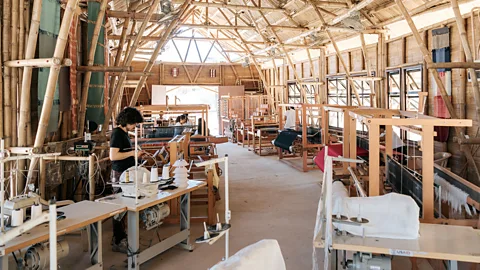
Of course, earthquake-resilience is not the only thing attracting people to bamboo. Architects around the world have started building grandiose yet sustainable structures with bamboo, from hulking pavilions in Vietnam to the bamboo gardens of Bangalore’s Kempegowda International Airport in India.
In Europe and in the US, though, where the only native species of bamboo is a woody grass found in the US southern states, its use is infrequent. The balmy climates of the southeast US, however, can support bamboo plants for commercial and construction use, which has caught the attention of some researchers.
Emergency bamboo
Bamboo can also be an extremely useful relief material in the aftermath of disasters, says Kaminski, who wrote a guide in 2018 on the use of bamboo in relief structures in the Rohingya refugee camps of Bangladesh.
Pakistani architect Yasmeen Lari has also pioneered the use of bamboo to construct relief homes after disasters, including the homes she built after an earthquake struck northern Afghanistan in 2015. “What we did was to make it very strong by inserting these steel bars into the foundations,” Lari says. “Everything was really joined together very well so that it would all sway.”
When you are in a bamboo house, I think you might be moved by the atmosphere – Liu Kewei
Lari then began designing ultra low-cost bamboo homes in Pakistan: mud brick structures with bamboo roofs and insertions of bamboo within the walls which relied solely on locally available materials and removed the need for steel. The structures were used as flood-resistant disaster shelters after the 2022 floods that left one-third of Pakistan under water. In 2023, Lari won a royal gold medal from the Royal Institute of British Architects in recognition of her humanitarian work in architecture.
Lari says she and researchers at the NED University of Engineering and Technology in Pakistan subjected a half-scale model of these structures to a shaking table test in 2021, simulating the strength of the 1995 7.2-magnitude earthquake in Kobe, Japan. It survived 100% of that earthquake’s strength, then 200%, then 250%. “Nothing happened,” Lari recalls. Only at 670% of its strength did the structure start to buckle, she says.
Lari’s homes, inspired by the traditional Dhajji method of timber patchwork construction, can be built for as little as $88 (£65). That’s less than one-tenth of what’s needed for each relief home constructed by the World Bank, says Lari (the World Bank told the BBC that the cost of reconstruction of a single room unit in Pakistan is around $1,400-1,600, or £1,050-1,200).
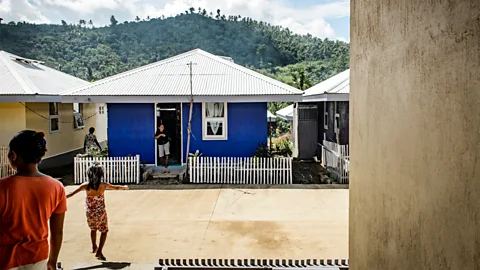
After the 2022 Pakistan floods, Lari says, the World Bank insisted reconstruction must be done in brick and concrete. “The vernacular traditions have never had a chance to survive or to be perpetuated,” he says.
But a World Bank spokesperson said that the ability to widely use technologies such as bamboo in reconstruction efforts is often limited by gaps in lab testing and local building codes. “[M]any local codes do not contain resilience provisions for traditional construction practices, which restricts the broader adoption of materials like bamboo,” they say.
In Pakistan, they add, bamboo’s use was limited by many factors, including the level of community acceptance, a lack of adequate skills and training for local craftsmen in comprehensive bamboo-based construction and there being no established treatment or testing facilities in the province, they add.
However, they say that the bank “recognises the value of locally adapted construction technologies, including bamboo, which can offer cost-effective, sustainable and resilient solutions in many contexts”. One example, they say, was the reconstruction in Colombia’s coffee growing region after the 1999 earthquake, where an official guidance note adopted by a Colombian engineering association established how bamboo could be safely and effectively used in construction.
In Pakistan, much like in the Philippines and Ecuador, there is a festering idea that bamboo is “the poor man’s material”, says Lari.
Today, though, this perception is being questioned more than ever. And while most bamboo structures are limited to one or two stories, architects are now experimenting with bamboo multi-story buildings and high rises – a potential proof of bamboo’s viability in large-scale, high-density structures.
Liu says that people who experience bamboo for the first time are often taken by the feeling that a stable, disaster-resistant structure can also make them feel more connected to nature.
“When you are in a bamboo house, I think you might be moved by the atmosphere,” she says. “When you enter into a natural environment, you will feel more comfortable.”


